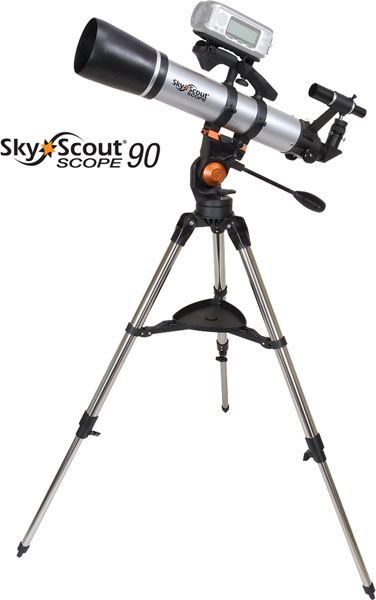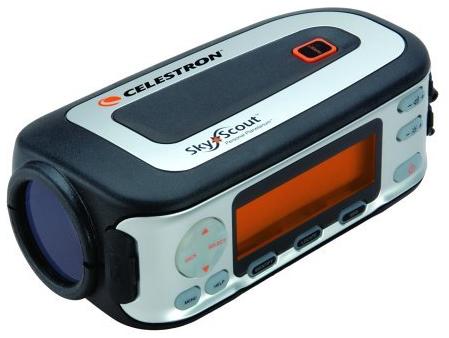When I first saw the Celestron SkyScout Scope 90 appear, I knew that some day, some how I was going to have to get my hands on one of these refractor telescopes. I am fascinated with my Celestron SkyScout Personal Planetarium and the thought of adding an easy-to-use telescope to it as as system was simply irresistible. My only thought was would this be the Celestron quality I’ve always known and loved… or would it be a disappointment?
The day the big box from Celestron arrived, my hands itched to take out the telescope and mount inside and see what it could do. Of course, the “astronomer’s curse” was in full force at the time and we all know that anyone who gets a new telescope has to endure at least a few days of clouds and rain before they’re allowed to use it. I was no exception. I kept watching the box and watching the skies; one of these nights, the SkyScout Scope 90 would be mine.
The moment the first sunny day arrived, the box was on the table and I was ready with a fresh, open mind; ready to see just how intuitive assembly would be and how the scope felt to my hands. With the neatly packed interior displayed, by some odd coincidence my hands chose to open the section that contained the mount and tripod first. Inwardly, I cringed. I’ve had a tremendous amount of experience with inexpensive telescopes and one of the major flaws with all of them is the mount and tripod. Please don’t tell me this is the same.
Please.
I needn’t have worried. The moment the Celestron altazimuth mount was freed from its styrofoam and plastic, I knew that my faith in Celestron was well placed. What I was holding in my hands might be lightweight – but it was in no respect cheap. Smooth, 1.5″ polished stainless steel legs were ended with well-attached feet. A critical link, the mechanism that tightens the tripod legs when extended, was rock solid and not prone to stripping out like competitor mounts. What’s more, the Celestron-quality altazimuth mount was already attached – fully assembled. While most of us (including me) are perfectly capable of assembling a mount and/or attaching it to the tripod, this extra Celestron feature scored heavily in their favor.
Why? The answer is simple.
For any of us who dis-assemble and re-assemble a scope frequently, you know the more often it is done, the harder it becomes on the parts. It’s also very wearing on some types of mounts and tripods to transport them fully assembled as well – one wrong move can mean stripped fittings and a forever “loose” scope. Not so in the case of the Celestron SkyScout Scope 90. This is one that is meant to be transported assembled and its anodized aluminum machinations are solid quality. You aren’t going to strip this Celestron mount out just by using it.
Next up? Scope rings. Here again we have a critical assembly part. Easily attached and Celestron quality. While the scope rings might seem like a minor thing, have you ever tried holding your optical tube steady with one hand while closing the scope rings and tightening them down with the other? Yeah. You get the picture. No one wants to take a chance at dropping their optical tube assembly and Celestron has thought about that. The tube rings have grips! In my estimation, this isn’t a minor point. This is a major convenience. By adding a “grip” feature on the tube rings, Celestron has made it easy for one person to set up the SkyScout Scope 90 – a person of any age and capability.
And now, the optical tube assembly itself. When the plastic came off, I discovered plastic underneath. Yes, it was a shock to discover the optical tube was plastic, but, this scope is under $300. Having faith in Celestron design, and also remembering how shocked I was that my first big dobsonian was cardboard, I hooked it up to the rings and was pleasantly surprised to find the dew shield is integrated. Well, hey! There’s another nice and thoughtful feature. The SkyScout Scope 90 is going to save you some money (and headaches) in the long run by already having a dew shield built right in!
Next up? Time to add the 6X30 finderscope to the quick release bracket. Here again is another very well thought out features by Celestron. For those not familiar with telescope terminology, a quick release dovetail is a type of slide that allows you to put on and take off the finderscope without messing up its alignment. A definite plus for those who transport their telescope and perfectly compatible with other types of finders – such as a red dot or green laser finder. I was also very pleased with the 6X30 image correct finder. It delivers upright images that are less confusing to the beginning astronomer and perfect for the daylight wildlife observer. To me, this is perfect aperture – capable of revealing fainter marker stars – but not so many as to be confusing with average star charts. The Celestron 6X30 finder was also very easily aligned and very secure in its housing. Both the quick release bracket and finderscope are high quality and should never need replacing. Score more points for the Celestron SkyScout Scope 90!
Now for the SkyScout Scope bracket. Viola. Again, the bracket attaches easily and securely and the Celestron SkyScout fits in it like a glove. Secure pegs match perfectly with the base of the SkyScout and an easy grip knob is provided should you wish to lock the personal planetarium down. Again, a perfect fit and easy alignment means no hassle on the user’s part and another big point in favor of this scope.
So how did it feel with all the bells and whistles attached? I went in prepared to be skeptical of having balance issues and within seconds was grinning like a fool. The pan handle control works like a charm and the clutch insures smooth and easy operation without feeling like the assembly is overloaded. On the contrary! The whole Celestron SkyScout Scope 90 balanced like a charm and there was no position that I put the scope in that felt unstable. I like confident equipment.
Are you ready for an optics test? I am. While I wasn’t too impressed with the included diagonal and 10mm eyepiece, the Celestron 40mm is the same quality that has graced my eyepiece case for two decades. Don’t get me wrong, for the diagonal and 10mm are perfectly acceptable, but I guarantee you’ll be using the included 40mm eyepiece in more than just the SkyScout Scope 90! The 40mm eyepiece is outstanding quality with good eye relief and field of view. While newcomers are terribly tempted to have that “high magnification” factor, Celestron has done you a favor in the eyepieces they choose to include. For the 90mm aperture Celestron SkyScout 90 at f/7, this particular eyepiece will give you bright, low power images that amaze you with richness of field. For lunar or planetary work, the included 10mm is right down at the limit of usable magnification. Trust Celestron, they honestly knew the two best eyepieces to pick for this telescope – not just ones to include
Terrestrial viewing? Superb. Very little color fringing and tack sharp images. Astronomical viewing? Outstanding. My first target was Saturn at low power. Crisp, clean, and well focused. (Although I haven’t mentioned it yet, the Celestron rack and pinion focuser on the SkyScout Scope 90 is also high quality. It’s very capable of fine adjustments and feels like it will last a lifetime. No slop!) What a delight to listen to the SkyScout Personal Planetarium tell me all about it while I was viewing! Oddly enough, others wanted to listen as well, so it was no problem to put a small, powered speaker right on the sturdy accessory tray. Next up? Mizar and Alcor – then Cor Caroli. Far from a tough split in either case, but the color correction is superb. How about deep sky? In the 40mm eyepiece both M81 and M82 were easily framed against their starry background and bright enough to be seen without aversion. What a pleasure! Other galaxies like M65 and M66 were easy. Even M51 and M104 were beginning to show structure and globular clusters like M3 and M5 some resolution. No vignetting… Just crisp, clean images. The plastic OTA? Guess what… Not only does it make the whole assembly lighter, but also promotes quicker cool down times.
Over the days – and away from the public eye – I continued to put the SkyScout Scope 90 to the test. These were the little things that only a backyard astronomer could appreciate – like knowing which star was Alpha Cancri so I could easily starhop to M67, or purposefully choosing difficult doubles like Porrima or Epsilon Bootes. Again and again, the Celestron SkyScout Scope 90 surprised me. Not only is it capable of the Messier objects, but a handsome portion of the NGC catalog as well. It performs well on the planets, and beyond the call of duty on the Moon.
All in all, you cannot go wrong with the Celestron SkyScout Scope 90. It’s extremely easy to assemble and its durability shines right through. Even if you never couple it with a Celestron SkyScout, the 90 will make an awesome beginner’s scope that won’t (unlike competitor’s similarly priced brands) fall apart in the user’s hands. No wonder Celestron guarantees it for two years! At only 18 lbs. it makes a great travel companion and for a great many users will provide a lifetime of fascination. I know I don’t want to let mine go.


